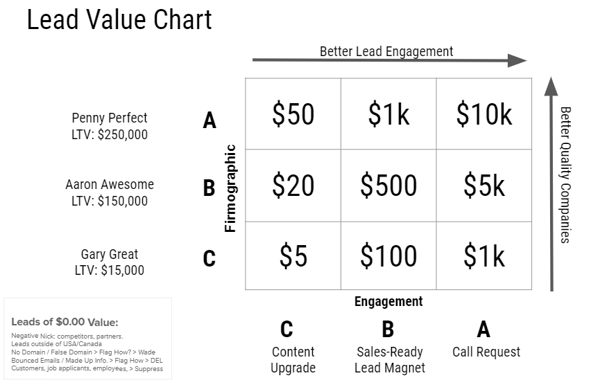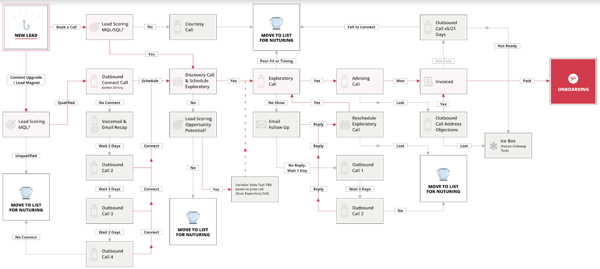When the leads are coming, and you're meeting revenue goals, there's only one question companies ask.
How do I scale?
You may think that if you can increase leads, you will get more customers and be able to scale faster. However, if you acquire too many leads that are a poor fit for your services or culture, you'll likely lose ground. Also, if you try to rush leads along too fast, you may kill your conversion rate.
So, how do you increase your sales velocity without sacrificing customer quality or experience? You have to learn how to fine-tune the systems that your teams have grown overly comfortable with and put an emphasis on improving your overall sales process.
Improve Your Sales Process with These 5 Powerful Tips
Sales velocity is a measurement that indicates how quickly you are making money. It’s calculated by multiplying your number of opportunities times your average deal size and close rate percentage and then dividing that by the overall length of your sales cycle.
The result of the sales velocity equation is a quantifiable metric you can use to determine how to produce more deals faster.
To influence your sales velocity, you need every part of your sales system firing right.
If you want a higher sales velocity, you need a strong Sales System that will help you:
- get more sales-ready, high-quality opportunities in your pipeline
- achieve a larger average deal size
- boost your win rate percentage
- shorten your overall sales cycle
This is why we recommend conducting an audit of your current systems as a first step.
In our experience, so many companies try to incorporate ideas they see working elsewhere—but they neglect to study their foundation. You can’t plan for improvement if you don’t know what your current metrics are.
These tips can help you find the gaps in your current processes that can help you improve the speed at which you’re able to close deals.
1. Stop Relying on Vanity Metrics to Measure Success
Vanity metrics are the numbers that people tend to focus on that seem important on the surface, but that won’t actually have a direct influence on the goal you’re trying to reach.
One of the most notorious vanity metrics is traffic.
While traffic numbers can be valuable information for some campaigns, the number of visitors you receive doesn't influence your sales velocity. Traffic simply means that you had more people visit your website — but it doesn’t provide information about the quality of the visitors or what they did next.
Sales, by nature, is revenue-driven. Qualified leads are significantly more valuable than visitors. This is why Growth-Based Marketing Tactics that skip the vanity metrics and focus on results can be a powerful partner in sales efforts.
So instead of focusing on metrics like how many shares your tweet earned, you should focus on the numbers that impact your revenue.
- How fast is your Sales team getting to the first touch?
- How many marketing qualified leads (MQLs) are entering the pipeline?
- What's the average deal value?
The fastest-growing companies limit their critical metrics to ones that directly impact their revenue.
You have to consider your goal and the metrics that will drive it.
If your goal is to increase brand awareness, then you have to focus on tactics and metrics that ensure that the right people (MQLs) are the ones becoming aware of your brand.
We recommend you monitor any metrics that impact sales and revenue. These metrics will help you see how you can drive more conversions at significantly faster rates:
- Marketing Qualified Leads
- Sales Qualified Leads
- Connections
- Deals
- Average Deal Value
- Sales Activities (Meetings, Calls, Emails)
2. Be Realistic with Your Service Level Agreement
As it relates to sales and marketing, a service-level agreement (SLA) defines how Sales and Marketing departments will work together to generate revenue for your company. It outlines what each department is responsible for and how they will collaborate to build effective processes for generating leads and closing sales.
The unfortunate truth is that many companies don't have SLAs, and those that do have them are using them incorrectly.
These companies use arbitrary numbers that aren't tied to revenue. They also don’t have processes in place to ensure that the SLA is followed. This creates dysfunction across the organization because each team moves in different directions instead of learning to work together.
A lack of lead scoring is the typical place that we see a breakdown in Sales and Marketing alignment.
When Marketing is focused on creating more leads, rather than on the quality of the lead, they're ignoring the metric that drives more revenue.
This lack of knowledge on lead quality means that Sales has to spend longer in the sales cycle with each contact, and the department sees a lower close rate because of it.
You should tie your SLA to the value that leads provide towards your revenue goal. SLA’s will be logically produced and refined every quarter based on actual data from the sales process.
For example, if a visitor downloads a lead magnet, they're worth a set value. If they request a meeting or call with Sales, they're worth more because there's a higher chance that lead will close.
Your SLA should set a monetary amount to each of these high-value indicating actions.
The Sales portion of the SLA outlines the duties that Sales will fulfill and their obligations towards the Marketing department. This includes things like how long it takes reps to reach out to leads, the average number of touches it takes before closing a deal, and the value of deals related to those leads.
Marketing’s obligations in the SLA relate to producing high-quality leads for Sales. They should be easier to work with—properly nurtured, prequalified, and showing actions that indicate they are “sales-ready” based on the criteria that Sales and Marketing define together.
SLAs hold everyone more accountable and increase work output. They give each department a specific goal to reach with the understanding of why it's important. The SLA provides flexibility in their work but also aligns both teams under one goal.
3. Build a Process Map to Guide Sales Reps
Sales reps have tend to use intuition as their guide in the sales process. The issue with playing by feel is that it sacrifices efficiency, it rarely captures best practices, and requires tailoring to every lead and every Sales rep.
Essentially, “trusting your gut” wastes time across the entire sales process.
Instead, companies should use a process map that guides reps through the entire process, step-by-step.
A process map works like a flowchart with if/then branches to allow them to respond to different situations in a predefined way. This flexibility gives reps an understanding of what to do in every situation.
It may seem rigid, but the map increases flexibility by and provides guidance in a variety of situations. Sales reps can move forward confidently and utilize knowledge gained through repetition that allows you to optimize your processes.
Every step includes specific scripts and templates that your organization has built from best practices. Reps can tailor these templates to match their tone or style, but the simple act of knowing which message to deliver and when dramatically increases the speed of the sales process and boosts confidence for both the lead and the Sales rep.
If you want to learn how to create a process that brings out the best in your organization—without all the implementation headaches—check out our Sales System page to dive deeper into what a winning sales process looks like.
4. Give Your Sales Team Paid Time to Improve Processes
Sales reps lose money if they aren’t actively working to close deals — and this mindset holds your company back. Your Sales team isn’t going to want to spend their time improving processes if it costs them money.
Taking time out to work on processes or collaborate with marketing decreases their stats and lowers their commission rate. Because of this, very few reps are willing to come back to the process to refine it.
This short-term mindset causes companies to run the same lackluster system until the business flops or stagnates.
A successful long-term strategy involves compensating your Sales team for time spent working on the actual process. Whether it's a financial incentive or reduced requirements for monthly numbers, reps should want to contribute to refining the system they use.
Giving Sales reps a safe block of time that won't count against their performance lets them engage with Marketing to align on messaging and provide feedback. It lets them fine-tune their messages and templates to increase performance.
Ultimately, these refinements will not only streamline your sales process, but they will also make it easier and faster for you to onboard more Sales staff and scale-up your efforts.
5. Leverage Professional Advice to Avoid Roadblocks
A streamlined and regularly groomed sales process can set you up for long-lasting, consistent results that can help you scale up intelligently.
If you partner with a professional agency that has experience in Sales Enablement and Sales and Marketing Alignment, they can help you identify potential problems and roadblocks quickly. Their expertise can help you move ahead faster with less stress, turnover, and frustration.
A skilled agency can help you:
- effectively utilize technology solutions like a CRM to track leads and customers from Marketing to Sales
- track meaningful metrics that impact your goals instead of wasting energy on vanity metrics
- build a strategic SLA that will improve alignment between your Sales and Marketing teams
At Lean Labs, we know what it takes to deliver results. We can show you the common problems with sales processes in your industry based on our extensive experience. We can also show you how you can leverage our hands-on guidance to bypass those very roadblocks and get results.
If you’re ready to skip the research and stop wasting time with guesswork, then let’s book a call and talk about how you can fix your sales process.








